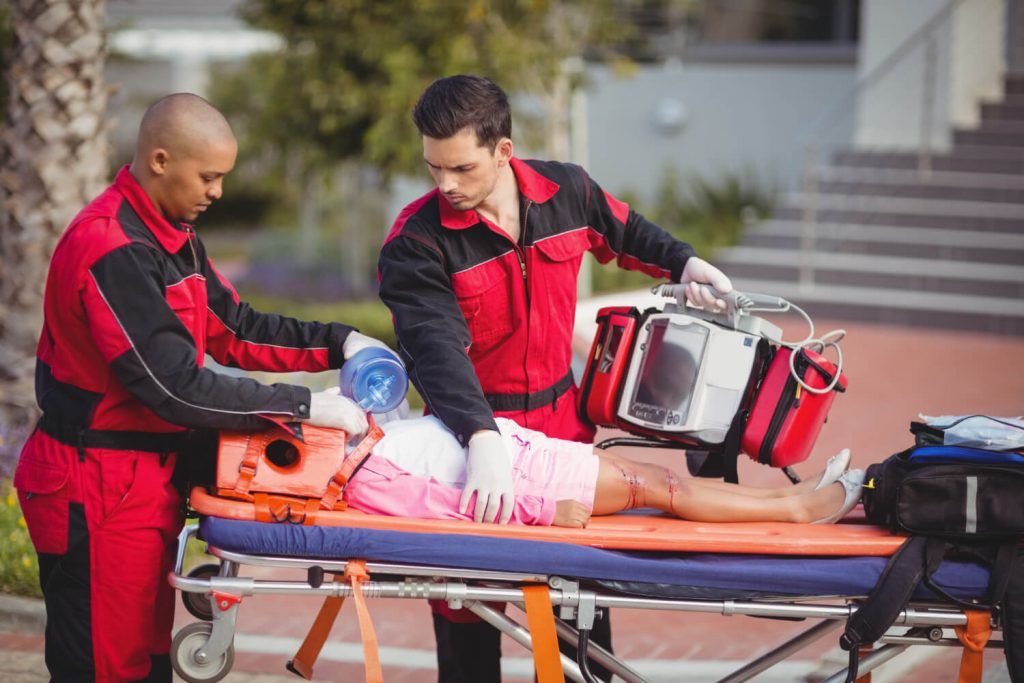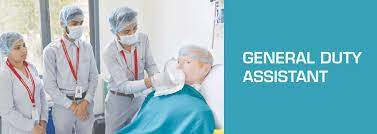Free Emergency Medical Technician- Advanced (1year Diploma Course)
Emergency Medical Technician- Advanced
Emergency Medical Technician (EMT) – Advanced in the Healthcare Industry is also known as a lifesaver or paramedic. EMT-Advanced has more training and internship requirements than the EMT-Basic and can undertake additional tasks, administer a greater range of medication and perform more procedures.
Brief Job Description:- Individuals at this job need to provide emergency medical support and care to individuals who are critically ill or injured and transport them to a medical facility within stipulated time limits Emergency Medical Technician- Advanced Course.
Personal Attributes: -This job requires individuals to work in a team and be comfortable in making decisions pertaining to their area of work. Individuals should be able to maintain composure in extremely stressful conditions in order to assess medical situations and perform emergency lifesaving procedures according to the methods in which training has been imparted to them. Individuals must always perform their duties in a calm, reassuring and efficient manner. The individual must be able to lift between 45 – 99 kilograms of weight with a partner, as the weight of patients will typically fall within that range. The fitness of the individual should be assessed using the Defence Man & Woman guidelines.
Respond to Emergency Calls (Advanced) Emergency Medical Technician- Advanced Course:-
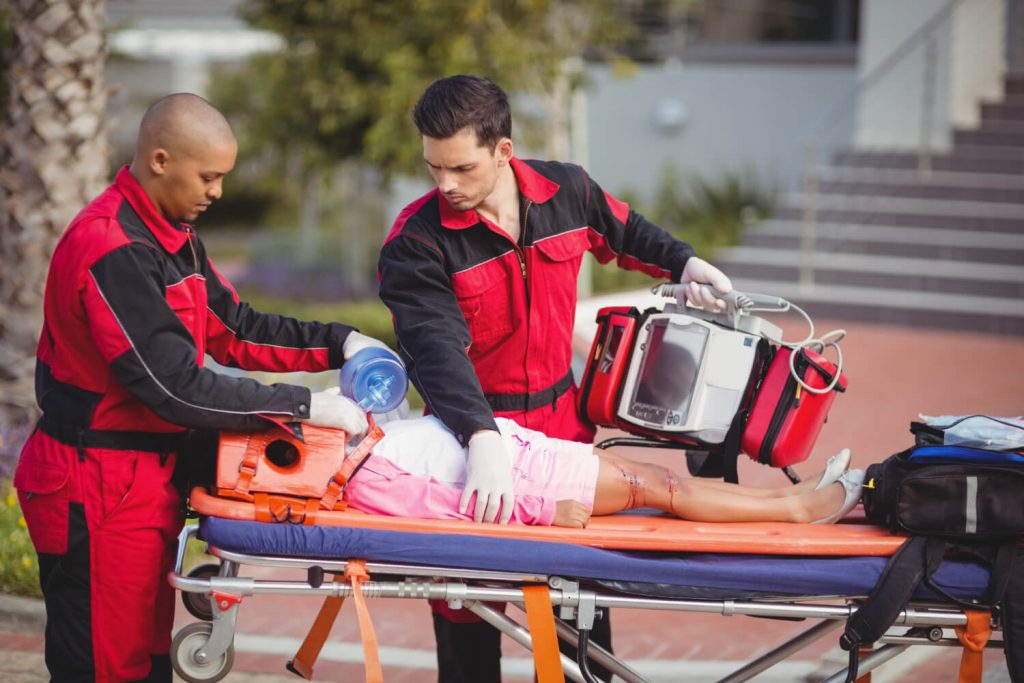
· Responding to emergency calls from the dispatch centre
· Collecting information about the type of emergency from the dispatch centre
· Preparing oneself for an emergency Free Emergency Medical Technician- Advanced (1year Diploma Course)
· Preparing the ambulance with required equipment
PC1. Understand the emergency codes used in the hospital for emergency situations
PC2. Reflect professionalism through use of appropriate language while speaking to the dispatch team
PC3. Use communication equipment such as mobile phones, radio communication equipment, megaphones and other equipment as required by the EMS provider
PC4. Evaluate the situation of the patient(s) on the basis of the call with the dispatch centre
PC5. Demonstrate teamwork while preparing for an emergency situation with a fellow EMT and/or a nurse
PC6. Recognise the boundary of one’s role and responsibility and seek supervision from the medical officer on duty when situations are beyond one’s competence and authority
PC7. Prepare for the emergency by practicing Body Substance Isolation (BSI). This includes putting on:
a. Hospital Gowns
b. Medical Gloves
c. Shoe Covers
d. Surgical Masks
e. Safety Glasses
f. Helmets
g. Reflective Clothing
PC8. Prepare the ambulance with the required medical equipment and supplies as per the medical emergency. A large selection of equipment and supplies specialised for Emergency Medical Services include diagnostic kits, disposables, and patient care products. The EMT should ensure all materials, supplies, medications and other items required for Advanced Life Support (ALS) have been stocked in the Ambulance Free Emergency Medical Technician- Advanced (1year Diploma Course)
PC9. Demonstrate active listening in interactions with the dispatch team, colleagues and the medical officer
PC10. Establish trust and rapport with colleagues
PC11. Maintain competence within one’s role and field of practice
PC12. Promote and demonstrate good practice as an individual and as a team member at all times
PC13. Identify and manage potential and actual risks to the quality and safety of practice
PC14. Evaluate and reflect on the quality of one’s work and make continuing improvements
PC15. Understand basic medico-legal principles
PC16. Function within the scope of care as defined by state, regional and local regulatory agencies
Free Emergency Medical Technician- Advanced (1year Diploma Course)Size up the scene at the site Emergency Medical Technician- Advanced Course:-
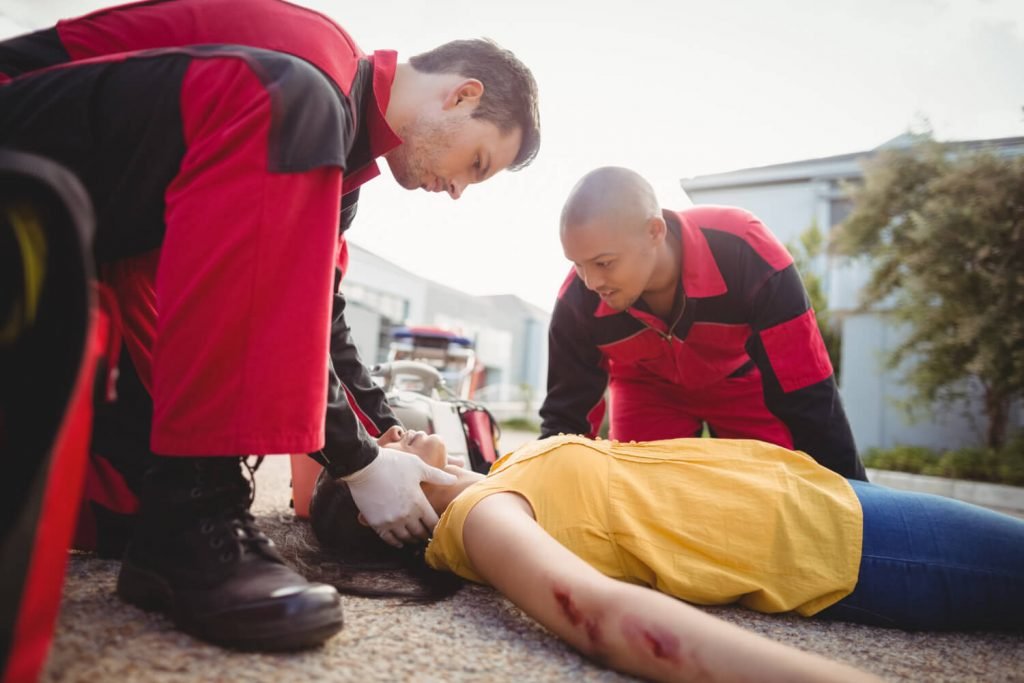
·Summing up the scene quickly and ensuring that it is safe by taking appropriate
· measures Collaborating with other emergency response agencies, if required
· Estimating the total number of patient(s) involved and calling for backup, if required
PC1. Ensure that all safety precautions are taken at the scene of the emergency
PC2. Introduce themselves to patient(s) and ask for their consent to any treatment
PC3. Understand the implications of nuclear, radioactive, biological, chemical and explosive incidents and take appropriate action
PC4. Collaborate effectively with other emergency response agencies and explain the situation clearly to them. This includes bomb disposal squads, fire departments, chemical, biological and nuclear agencies Free Emergency Medical Technician- Advanced (1year Diploma Course)
PC5. Reassure patient(s) and bystanders by working in a confident, efficient manner
PC6. Work expeditiously while avoiding mishandling of patient(s) and undue haste
PC7. Recognise and react appropriately to persons exhibiting emotional reactions
PC8. Interact effectively with the patient(s), relatives and bystanders who are in stressful situations
PC9. Obtain information regarding the incident through accurate and complete scene assessment and document it accordingly
PC10. Evaluate the scene and call for backup if required Free Emergency Medical Technician- Advanced (1year Diploma Course)
PC11. Recognise the boundary of one’s role and responsibility and seek supervision when situations are beyond one’s competence and authority
PC12. Maintain competence within one’s role and field of practice
PC13. Collaborate with the law agencies at a crime scene Emergency Medical Technician- Advanced Course.
PC14. Promote and demonstrate good practice as an individual and as a team member at all times PC15. Identify and manage potential and actual risks to the quality and safety of work done
PC16. Evaluate and reflect on the quality of one’s work and make continuing improvements
PC17. Understand basic medico-legal principles
PC18. Function within the scope of care defined by state, regional and local regulatory

Evidence based Protocol while managing patients:-
1.Following the prescribed procedures and steps involved in an emergency or
2. triage context Managing cases where the patient refuses treatment
To be competent, the user/individual on the job must be able to:
PC1. Understand the appropriate and permissible medical service procedures which may be rendered by an EMT to a patient not in a hospital. For example, steps to be followed for cardiovascular emergencies or emergency of an environmental nature like burns, hypothermia
PC2. Understand the communication protocols for medical situations that require direct voice communication between the EMT and the Medical officer prior to the EMT rendering medical services to the patients outside the hospital
PC3. Adhere to laws, regulations and procedures relating to the work of an EMT Free Emergency Medical Technician- Advanced (1year Diploma Course)
PC4. Demonstrate professional judgement in determining treatment modalities within the parameters of relevant protocols
PC5. Understand the universal approach to critical patient care and package-uppatient-algorithm(transport protocol)
Assess Patient at the site (Advanced) Emergency Medical Technician- Advanced Course:-
1.Assessing the situation and condition of the patient based on an examination and
2. supporting tests Arriving at a probable diagnosis
To be competent, the user/individual on the job must be able to:
PC1. Explain clearly:
o An EMT’s role and scope, responsibilities and accountability in relation to the assessment of health status and needs
o What information need to be obtained and stored in records
o With whom the information might be shared Free Emergency Medical Technician- Advanced (1year Diploma Course)
o What is involved in the assessment
PC2. Obtain informed consent of the patient for the assessment process, unless impossible as a consequence of their condition
PC3. Conduct all observations and measurements systematically and thoroughly in order of priority (including Airway, Breathing, Circulation)
PC4. Respect the patient’s privacy, dignity, wishes and beliefs
PC5. Minimise any unnecessary discomfort and encourage the patient to participate as fully as possible in the process
PC6. Communicate with the patient clearly and in a manner and pace that is appropriate to:
o Their level of understanding
o Their culture and background
o Their need for reassurance and support
PC7. Recognise promptly any life-threatening or high risk conditions
PC8. Make full and effective use of any protocols, guidelines and other sources of guidance and advice to inform decision making
PC9. Assess the condition of the patient by:
a. Observing patient position

b.Observing the colour of the skin as well as ease of breathing and paying attention to any signs of laboured breathing or coughing
c. Checking if there is any bleeding from the nose or ears
d. Looking at the pupil dilation/difference in pupil sizes, as it may besuggestive of concussion
e. Checking if the patient is under the effect of alcohol or any other drug
f. Checking the patient’s mouth to ensure the airway is clear Free Emergency Medical Technician- Advanced (1year Diploma Course)
g. Gently checking the neck, starting from the back
h. Checking for any swelling or bruises
i. Checking the chest to ascertain if any object is stuck Free Emergency Medical Technician- Advanced (1year Diploma Course)
j. Checking the ribcage for bruising or swelling and the abdomen for any kind of swelling or lumps
k.Checking for any damage to the pelvis o Asking the victim if they are able to feel their legs
l.Observing the colour of toes to check for any circulation problems Free Emergency Medical Technician- Advanced (1year Diploma Course)
PC10. Use appropriate equipment if required Free Emergency Medical Technician- Advanced (1year Diploma Course)
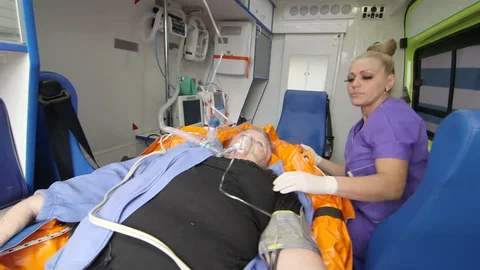
Patient Triage based on the defined clinical criteria of severity of illness Emergency Medical Technician- Advanced Course:-
Description:- This OS unit is about a process for sorting injured people into groups based on their need for or likely benefit from immediate medical treatment. It aims to ensure that patients are treated in order of their clinical urgency i.e. the need for time-critical intervention. Triage also allows for the allocation of the patient to the most appropriate assessment and treatment area.
To be competent, the user/individual on the job must be able to:
PC1. Have the expertise to quickly assess whether the patient requires immediate lifesaving intervention or whether they could wait
PC2. Know how to check all the vital signs
PC3. Identify a high-risk case
PC4. Assess the kind of resources the person will require. For e.g. The EMT should know the standard resources required for a person who comes to the emergency department for a similar ailment
PC5. Communicate clearly and assertively
PC6. Collaboratively be able to supervise/work collaboratively with other departments
PC7. Multitask without compromising on quality and accuracy of care provided
PC8. Use SALT method in day-to-day handling and START in mass casualty handling and disasters
Manage Cardiovascular Emergency (Advanced):-

PC1. Describe the structure and function of the cardiovascular system
PC2. Provide emergency medical care to a patient experiencing chest pain/discomfort
PC3. Identify the symptoms of hypertensive emergency
PC4. Identify the indications and contraindications for automated external defibrillation (AED)
PC5. Explain the impact of age and weight on defibrillation
PC6. Discuss the position of comfort for patients with various cardiac emergencies
PC7. Establish the relationship between airway management and the patient with cardiovascular compromise
PC8. Predict the relationship between the patient experiencing cardiovascular compromise and basic life support
PC9. Explain that not all chest pain patients result in cardiac arrest and do not need to be attached to an automated external defibrillator
PC10. Explain the importance of pre-hospital Advanced Life Support (ALS) intervention if it is available
PC11. Explain the importance of urgent transport to a facility with Advanced Life Support if it is not available in the pre-hospital setting
PC12. Explain the usage of aspirin and clopidogrel
PC13. Differentiate between the fully automated and the semi-automated defibrillator
PC14. Discuss the procedures that must be taken into consideration for standard operations of the various types of automated external defibrillators
PC15. Assure that the patient is pulseless and apnoeic when using the automated external defibrillator PC16. Identify circumstances which may result in inappropriate shocks
PC17. Explain the considerations for interruption of CPR, when using the automated
Summarise the speed of operation of automated external defibrillation
PC19. Discuss the use of remote defibrillation through adhesive pads
PC20. Operate the automated external defibrillator
PC21. Discuss the standard of care that should be used to provide care to a patient with recurrent ventricular fibrillation and no available ACLS
PC22. Differentiate between the single rescuer and multi-rescuer care with an automated external defibrillator
PC23. Explain the reason for pulses not being checked between shocks with an automated external defibrillator
PC24. Identify the components and discuss the importance of post-resuscitation care
PC25. Explain the importance of frequent practice with the automated external defibrillator
PC26. Discuss the need to complete the Automated Defibrillator: Operator’s Shift checklist Emergency Medical Technician- Advanced Course.
PC27. Explain the role medical direction plays in the use of automated external defibrillation
PC28. State the reasons why a case review should be completed following the use of the automated external defibrillator
PC29. Discuss the components that should be included in a case review
PC30. Discuss the goal of quality improvement in automated external defibrillation
PC31. Recognise the need for medical direction of protocols to assist in the emergency medical care of the patient with chest pain
PC32. List the indications for the use of nitro-glycerine
PC33. State the contraindications and side effects for the use of nitro-glycerine
PC34. Perform maintenance checks of the automated external defibrillator
PC35. Perform ECG tracing
PC36. Perform manual defibrillation, cardioversion and transcutaneous pacing
PC37. Manage acute heart failure
Manage Cerebrovascular Emergency Emergency Medical Technician- Advanced Course:-
Identifying the symptoms of a stroke
· Managing patients having a stroke
· Following the prescribed procedures and steps involved in a cerebrovascular
· emergency situation
To be competent, the user/individual on the job must be able to:
PC1. Describe the basic types, causes, and symptoms of stroke
PC2. Provide emergency medical care to a patient experiencing symptoms of a stroke
PC3. Manage airway, breathing, and circulation
PC4. Assess the patient’s level of consciousness and document any signs of stroke
PC5. Assess vital signs: Blood pressure, heart rate, and respiratory rate
PC6. Perform a standardised pre-hospital stroke scale assessment such as the Cincinnati pre-hospital stroke scale
PC7. Check serum blood sugar
PC8. Collect critical background information on the victim and the onset of the stroke symptoms such as the medical history (especially any past strokes), the estimate of the time since any potential stroke symptoms first appeared, current medical conditions of the patient and current medications
PC9. Determine the time of onset of symptoms
PC10. Explain how patients, family, or bystanders should respond to a potential stroke
PC11. Discuss the actions recommended for emergency responders to potential stroke victims
PC12. Explain the importance of transporting stroke patients immediately to an emergency department that has the personnel and equipment to provide comprehensive acute stroke treatment
PC13. Carry out first triage of potential stroke victims
PC14. Expedite transport of the patient to the nearest hospital equipped to handle strokes
PC15. Explain the importance of immediately notifying the Emergency Department
of the hospital of the arrival of a potential stroke victim
PC16. Administer an IV line and oxygen and monitor the functioning of the heart on-route to the hospital
PC17. Forward a written report to the emergency department with details on medical history and onset of the stroke symptoms
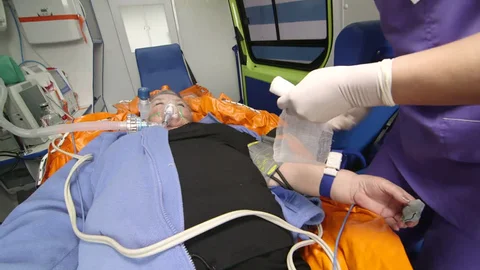
Manage Allergic Reaction:- To be competent, the user/individual on the job must be able to:
PC1. Recognise the patient experiencing an allergic reaction
PC2. Perform the emergency medical care of the patient with an allergic reaction
PC3. Establish the relationship between the patient with an allergic reaction and airway management PC4. Recognise the mechanisms of allergic response and the implications for airway management
PC5. State the generic and trade names, medication forms, dose, administration, action, and contraindications for the epinephrine auto-injector
PC6. Administer treatment appropriately in case of not having access to epinephrine auto-injectors
PC7. Evaluate the need for medical emergency medical care for the patient with an allergic reaction
PC8. Differentiate between the general category of those patients having an allergic reaction and those patients having a severe allergic reaction, requiring immediate medical care including immediate use of epinephrine auto-injector
Manage Poisoning or Overdose (Advanced):- To be competent, the user/individual on the job must be able to:
PC1. Recognise various ways that poisons enter the body
PC2. Recognise signs/symptoms associated with various poisoning
PC3. Perform the emergency medical care for the patient with possible overdose
PC4. Perform the steps in the emergency medical care for the patient with suspected poisoning
PC5. Establish the relationship between the patient suffering from poisoning or overdose and airway management
PC6. State the generic and trade names, indications, contraindications, medication form, dose, administration, actions, side effects and re-assessment strategies for activated charcoal
PC7. Recognise the need for medical direction in caring for the patient with poisoning or overdose
PC8. Perform gastric lavage

Manage Environmental Emergency:- Identifying Environmental emergencies
· Managing patients with symptoms of exposure to extreme heat/col
· Following the prescribed procedures and steps involved in exposure to extreme
· environmental situations
To be competent, the user/individual on the job must be able to:
PC1. Recognise the various ways by which body loses heat
PC2. List the signs and symptoms of exposure to cold
PC3. Perform the steps in providing emergency medical care to a patient exposed to cold
PC4. List the signs and symptoms of exposure to heat
PC5. Perform the steps in providing emergency care to a patient exposed to heat
PC6. Recognise the signs and symptoms of water-related emergencies
PC7. Identify the complications of near-drowning
PC8. Perform emergency medical care for bites and stings Emergency Medical Technician- Advanced Course.
PC9. Explain various relevant National Disaster Management Agency (NDMA) guidelines
Manage Behavioural Emergency (Advanced):- To be competent, the user/individual on the job must be able to:
PC1. Recognise the general factors that may cause an alteration in a patient’s behaviour
PC2. Recognise the various reasons for psychological crises
PC3. Identify the characteristics of an individual’s behaviour which suggest that the patient is at risk for suicide
PC4. Identify special medical/legal considerations for managing behavioural emergencies
PC5. Recognise the special considerations for assessing a patient with behavioural problems
PC6. Identify the general principles of an individual’s behaviour, which suggest the risk for violence
PC7. Identify physical and chemical methods to calm behavioural emergency patients
Manage Obstetrics/Gynaecology emergencies:-
To be competent, the user/individual on the job must be able to:
PC1. Identify the following structures: Uterus, vagina, foetus, placenta, umbilical cord, amniotic sac, and perineum
PC2. Identify and explain the use of the contents of an obstetrics kit
PC3. Identify pre-delivery emergencies
PC4. State indications of an imminent delivery
PC5. Differentiate the emergency medical care provided to a patient with predelivery emergencies from a normal delivery
PC6. Perform the steps in pre-delivery preparation of the mother
PC7. Establish the relationship between body substance isolation and childbirth
PC8. Perform the steps to assist in the delivery
PC9. State the steps required for care of the baby as the head appears
PC10. Explain how and when to cut the umbilical cord
PC11. Perform the steps in the delivery of the placenta
PC12. Perform the steps in the emergency medical care of the mother post-delivery
PC13. Summarise neonatal resuscitation procedures
PC14. Identify the procedures for the following abnormal deliveries: Breech birth, multiple births, prolapsed cord, limb presentation
PC15.Differentiate the special considerations for multiple births
PC16.Recognise special considerations of meconium
PC17. Identify special considerations of a premature baby
PC18. Perform the emergency medical care of a patient with a gynaecological emergency
PC19. Perform steps required for emergency medical care of a mother with excessive bleeding
PC20.Complete a Pre-Hospital Care report for patients with obstetrical/gynaecological emergencies
Manage Bleeding and Shock:-
To be competent, the user/individual on the job must be able to:
PC1. Recognise the structure and function of the circulatory system
PC2. Differentiate between arterial, venous and capillary bleeding
PC3. State methods of emergency medical care of external bleeding
PC4. Establish the relationship between body substance isolation and bleeding
PC5. Establish the relationship between airway management and the trauma patient
PC6. Establish the relationship between mechanism of injury and internal bleeding
PC7. Recognise the signs of internal bleeding
PC8. Perform the steps in the emergency medical care of the patient with signs and symptoms of internal bleeding
PC9. Recognise the signs and symptoms of shock (hypoperfusion)
PC10. Perform the steps in the emergency medical care of the patient with signs and symptoms of shock (hypoperfusion)
PC11. Recognize different types of shock and initiate appropriate medical management
Manage Soft Tissue Injury and Burns:-
To be competent, the user/individual on the job must be able to:
PC1. Recognise the major functions of the skin
PC2. Recognise the layers of the skin
PC3. Establish the relationship between body substance isolation (BSI) and soft tissue injuries
PC4. Recognise the types of closed soft tissue injuries
PC5. Perform the emergency medical care of the patient with a closed soft tissue injury
PC6. State the types of open soft tissue injuries
PC7. Recognise the emergency medical care of the patient with an open soft tissue injury
PC8. Recognise the emergency medical care considerations for a patient with a penetrating chest injury
PC9. Perform the emergency medical care considerations for a patient with an open wound to the abdomen
PC10. Differentiate the care of an open wound to the chest from an open wound to the abdomen PC11. Classify burns
PC12. Recognise superficial burn
PC13. Recognise the characteristics of a superficial burn
PC14. Recognise partial thickness burn
PC15. Recognise the characteristics of a partial thickness burn
PC16. Recognise full thickness burn
PC17. Recognise the characteristics of a full thickness burn
PC18. Perform the emergency medical care of the patient with a superficial burn
PC19. Perform the emergency medical care of the patient with a partial thickness burn
PC20. Perform the emergency medical care of the patient with a full thickness burn
PC21. Recognise the functions of dressing and bandaging
PC22. Describe the purpose of a bandage
PC23. Perform the steps in applying a pressure dressing
PC24. Establish the relationship between airway management and the patient with chest injury, burns, blunt and penetrating injuries
PC25. Know the ramification of improperly applied dressings, splints and tourniquets
PC26. Perform the emergency medical care of a patient with an impaled object
PC27. Perform the emergency medical care of a patient with an amputation
PC28. Perform the emergency care for a chemical burn
PC29. Perform the emergency care for an electrical burn Emergency Medical Technician- Advanced Course.
PC30. Recognise inhalation injury and perform emergency care
Manage musculoskeletal injuries:-
To be competent, the user/individual on the job must be able to:
PC1. Recognise the function of the muscular system
PC2. Recognise the function of the skeletal system
PC3. Recognise the major bones or bone groupings of the spinal column; the thorax; the upper extremities; the lower extremities
PC4. Differentiate between an open and a closed painful, swollen, deformed extremity
PC5. Manage musculoskeletal injuries including thoracic and abdominal injuries
PC6. State the reasons for splinting
PC7. List the general rules of splinting
PC8. Ramification & complications of splinting
PC9. Perform the emergency medical care for a patient with a painful, swollen, deformed extremity
PC10. How to apply pelvic binder techniques for fracture of pelvis
Manage Injuries to head and spine:- To be competent, the user/individual on the job must be able to: PC1. State the components of the nervous system
PC2. List the functions of the central nervous system
PC3. Recognise the structure of the skeletal system as it relates to the nervous system
PC4. Relate mechanism of injury to potential injuries of the head and spine
PC5. Recognise the implications of not properly caring for potential spine injuries
PC6. State the signs and symptoms of a potential spine injury
PC7. Recognise the method of determining if a responsive patient may have a spine injury
PC8. Relate the airway emergency medical care techniques to the patient with a suspected spine injury PC9. Identify how to stabilise the cervical spine
PC10. Indications for sizing and using a cervical spine immobilisation device Emergency Medical Technician- Advanced Course.
PC11. Establish the relationship between airway management and the patient with head and spine injuries
PC12.Recognise a method for sizing a cervical spine immobilisation device
PC13. Log roll a patient with a suspected spine injury
PC14. Secure a patient to a long spine board
PC15. List instances when a short spine board should be used
PC16. Immobilise a patient using a short spine board
PC17.Recognise the indications for the use of rapid extrication
PC18.Understand the steps in performing rapid extrication
PC19. Identify the circumstances when a helmet should be left on the patient
PC20. Identify the circumstances when a helmet should be removed
PC21. Identify alternative methods for removal of a helmet
PC22. Stabilise patient’s head to remove the helmet
PC23.Differentiate how the head is stabilised with a helmet compared to without a helmet
PC24. Immobilise paediatric and geriatric victims
PC25.Manage scalp bleeding
PC26.Manage eye injury
Manage Infants, Neonates and Children:-
To be competent, the user/individual on the job must be able to:
PC1. Identify the developmental considerations for the age groups of infants, toddlers, pre-school, school age and adolescent
PC2. Identify differences in anatomy and physiology of the infant, child and adult patient
PC3. Differentiate the response of the ill or injured infant or child (age specific) from that of an adult PC4. Understand various causes of respiratory emergencies
PC5. Differentiate between respiratory distress and respiratory failure
PC6. Perform the steps in the management of foreign body airway obstruction
PC7. Implement emergency medical care strategies for respiratory distress and respiratory failure
PC8. Identify the signs and symptoms of shock (hypoperfusion) in the infant and child patient
PC9. Recognise the methods of determining end organ perfusion in the infant and child patient
PC10. Identify the usual cause of cardiac arrest in infants and children versus adults
PC11.Recognise the common causes of seizures in the infant and child patient
PC12. Perform the management of seizures in the infant and child patient
PC13.Differentiate between the injury patterns in adults, infants, and children
PC14. Perform the field management of the infant and child trauma patient
PC15. Summarise the indicators of possible child abuse and neglect
PC16.Recognise the medical legal responsibilities in suspected child abuse
PC17. Recognise need for EMT debriefing following a difficult infant or child transport
Manage respiratory emergency:-
To be competent, the user/individual on the job must be able to:
PC1. Recognise the anatomical components of the upper airway including:
a. Nasopharynx
b. Nasal air passage
c. Pharynx
d. Mouth
e. Oropharynx
f. Epiglottis
PC2. Recognise the anatomical components of the lower airway including:
a. Larynx
b. Trachea
c. Alveoli
d. Bronchi
e. Carina
f. Diaphragm
PC3. Recognise the characteristics of normal breathing Emergency Medical Technician- Advanced Course.
PC4. Recognise the signs of abnormal breathing including:
a. Dyspnoea
b. Upper airway obstruction
c. Acute pulmonary oedema
d. Chronic obstructive pulmonary disease
e. Bronchitis f. Emphysema
g. Pneumothorax
h. Asthma
i. Pneumonia
j. Pleural effusion
k. Pulmonary embolism
l. Hyperventilation
PC5. Recognise the characteristics of abnormal breath sounds
PC6. Recognise the characteristics of irregular breathing patterns
PC7. Complete a focused history and physical exam of the patient
PC8. Establish airway in patient with respiratory difficulties
PC9. Contact Dispatch and Medical Control for choosing nebulizer therapy
PC10. Understand the various types of Metered Dose Inhalers including:
a. Preventil
b. Ventoiln
c. Alupent
d. Metaprel
e. Brethine
f. Albuterol
g. Metaproterenol
h. Terbutaline
PC11. Understand the contraindications and side effects for various types of Metered Dose Inhalers
Manage severe abdominal pain:-
To be competent, the user/individual on the job must be able to:
PC1. Recognise the anatomical components of the abdomen and their functions including:
- Left Upper Quadrant
o Most of the stomach
o Spleen
o Pancreas
o Large intestine
o Small intestine
o Left kidney (upper portion)
- Right Upper Quadrant
o Liver
o Gallbladder
o Part of the large intestine
o Right kidney (upper portion)
o Small intestine
- Right Lower Quadrant
o Appendix
o Large intestine
o Female reproductive organs
o Small intestine
o Right kidney (lower portion)
o Right ureter
o Right ovary & fallopian tube
- Left Lower Quadrant
o Large intestine
o Small intestine
o Left kidney (lower portion)
o Left ureter
o Left ovary
o Left fallopian tube
- Midline structures
o Small intestine
o Urinary bladder
o Uterus
PC2. Recognise the symptoms and cause of visceral pain
PC3. Recognise the symptoms and causes of parietal pain
PC4. Recognise the symptoms and possible causes of referred pain including:
a. Right shoulder (or neck, jaw, scapula) – possible irritation of the diaphragm (usually on the right); gallstone; subphrenic absess; free abdominal blood
b. Left shoulder (or neck, jaw, scapula) – possible irritation of the diaphragm (usually on the left); ruptured spleen; pancreatic disease or cancer; subphrenic absess; abdominal blood
c. Midline, back pain – aortic aneurysm or dissection; pancreatitis, pancreatic cancer, kidney stone d. Mid-abdominal pain – small bowel irritation, gastroenteritis, early appendicitis
e. Lower abdominal pain – diverticular disease (herniations of the mucosa and submucosa of the intestines), Crohn’s disease (a type of inflammatory bowel disease), ulcerative colitis Emergency Medical Technician- Advanced Course.
f. Sacrum pain – perirectal abscess, rectal disease
g. Epigastrium pain – peptic, duodenal ulcer; gallstone, hepatitis, pancreatitis, angina pectoris h. Testicular pain – renal colic; appendicitis
PC5. Complete a focused history and physical exam of the patient including:
a. Visual inspection
b. Auscultating the abdomen
c. Palpating the abdomen
PC6. Establish airway in patient
PC7. Place patient in position of comfort
PC8. Calm and reassure the patient
PC9. Look for signs of hypoperfusion
PC10. Recognise possible diagnoses for abdominal pain
PC11. State the treatment for managing various causes of abdominal pain
PC12. Recognise potential diagnoses which imply the condition of the patient may deteriorate and highlight the need for frequent reassessment and advanced life support interventions
PC13. Alert the Emergency Centre/ Healthcare provider in advance of a priority case (when required)
Manage Mass Casualty Incident:-
To be competent, the user/individual on the job must be able to:
PC1. Establish an Incident Management Structure on arrival at the scene including:
a. Designating an Incident Commander to manage the incident
b. As Incident Commander, designating Triage Team(s), Treatment Team(s), and a Transport Officer
PC2. Set up separate areas for treatment, triage and transport
PC3. Conduct an initial triage of patients by using the START triage model for adult patients, JumpSTART Triage for paediatric patients and the SMART triage tagging system
PC4. Use appropriate personal protective equipment while conducting initial triage
PC5. Tag severity/ criticality of patient using colour coded tags
PC6. Direct non-injured and/or slightly injured victims to the triage area set up for those with minor injuries
PC7. Monitor patients with minor injuries for changes in their condition
PC8. Maintain an open airway and stop uncontrolled bleeding
PC9. Extract patients from the casualty area based on initial triage to designated triage and treatment areas
PC10. Use equipment like cots and litters for extraction where required Emergency Medical Technician- Advanced Course.
PC11. Re-triage patients extracted to the triage and treatment areas
PC12. Provide treatment and deliver patients to transport area
PC13. Transport patients to healthcare facility
PC14. Alert healthcare facilities in advance of possible arrival of multiple patients
Select the proper provider institute for transfer:- To be competent, the user/individual on the job must be able to:
PC1. Explain to the patient about his role and the reason for selecting a particular health provider PC2. Consolidate complete medical history of the patient with the severity of the damage and impending risk in terms of time and the kind of treatment required
PC3. Allocate patient to the nearest provider institute
PC4. Base the allocation on the kind of care required namely primary, secondary or tertiary care centres
PC5. Make sure that the selection of the institute is in adherence with the legal regulation
PC6. Obtain guidance from medical officer for selection of proper provider institute
PC7. Provide pre-arrival information to the receiving hospital
PC8. Obtain guidance of medical officer when ambulance needed to be stopped enroute (e.g. during emergency child birth)
Transport patient to the provider institute:-
To be competent, the user/individual on the job must be able to:
PC1. Adhere fully to the rules and regulations related to the usage of ground and air transport
PC2. Adhere fully to the steps involved in treating and transporting the patient
PC3. Positively manage situations where transport is a problem
PC4. Allocate the means of transport keeping in mind the emergency, weather conditions and availability of transport
PC5. Adhere fully to procedures once the patient reaches the hospital
PC6. Use correct medication and equipment for treatment of immediate threats to life
Manage Patient Handover to the provider institute:-
To be competent, the user/individual on the job must be able to:
PC1. Provide a verbal report to the medical staff on the condition of the patient and initial findings PC2. Complete the Patient Care Report (PCR) and hand it over to the medical staff
PC3. Hand over the consent form signed by the patient or a relative
Manage diabetes emergency:-
To be competent, the user/individual on the job must be able to:
PC1. Identify the patient taking diabetic medications and the implications of a diabetes history
PC2. Perform the steps in the emergency medical care of the patient taking diabetic medicine with a history of diabetes
PC3. Establish the relationship between airway management and the patient with altered mental status
PC4. Recognize the generic and trade names, medication forms, dose, administration, action, and contraindications for oral glucose
PC5. Evaluate the need for medical direction in the emergency medical care of the diabetic patient
Manage advanced venous access and administration of medications:-
To be competent, the user/individual on the job must be able to:
PC1. Recognise the specific anatomy and physiology pertinent to medication administration
PC1. Differentiate temperature readings between the Centigrade and Fahrenheit scales
PC2. Discuss formulas as a basis for performing drug calculations
PC3. Calculate oral and parenteral drug dosages for all emergency medications administered to adults, infants and children
PC4. Calculate intravenous infusion rates for adults, infants, and children
PC5. Discuss legal aspects affecting medication administration
PC6. Discuss medical asepsis and the differences between clean and sterile techniques
PC7. Describe use of antiseptics and disinfectants
PC8. Describe the use of universal precautions and body substance isolation (BSI) procedures when administering a medication
PC9. Describe the indications, equipment needed, techniques utilized, precautions, and general principles of peripheral venous cannulation
PC10. Describe the indications, equipment needed, techniques utilized, precautions, and general principles of intraosseous needle placement and infusion
PC11. Describe the indications, equipment needed, techniques utilized, precautions, and general principles of administering medications by the inhalation route
PC12. Differentiate among the different dosage forms of oral medications Emergency Medical Technician- Advanced Course.
PC13. Describe the equipment needed and general principles of administering oral medications PC14. Describe the indications, equipment needed, techniques utilized, precautions, and general principles of rectal medication administration
PC15. Describe the equipment needed, techniques utilized, complications, and general principles for the preparation and administration of parenteral medications
PC16. Differentiate among the different percutaneous routes of medication administration
PC17. Differentiate among the different parenteral routes of medication administration
PC18. Describe the purpose, equipment needed, techniques utilized, complications, and general principles for
PC19. obtaining a blood sample
PC20. Describe disposal of contaminated items and sharps
PC21. Synthesize a pharmacologic management plan including medication administration
PC22. Integrate pathophysiological principles of medication administration with patient management
PC23. Comply with universal precautions and body substance isolation
Manage critical care aeromedical and inter-facility transport:-
To be competent, the user/individual on the job must be able to:
PC1. Understand the role of the critical care inter-facility transport teams in the patient care continuum
PC2. Understand the importance of providing the highest quality of care in a timely and safe manner
PC3. Understand how the needs and characteristics of patients influence and drive the competencies of critical care inter-facility transport professionals
PC4. Define and differentiate between the following
a. Pre-hospital Emergency Medical Services
b. Inter-facility EMS transport
c. Critical Care
d. Critical Care Transport
PC5. Compare and contrast the role of critical care inter-facility transport with the Emergency Medical Services pre-hospital system
PC6. Describe roles of team members in critical care inter-facility transport
PC7. Differentiate between critically ill trauma and medical patient transport theories a. Scoop and run b. Stay and play/resuscitate
PC8. Describe safe transport techniques
PC9. Describe appropriate transport equipment necessary for various critical care inter-facility transports
PC10. Describe the pertinent rules and regulations for critical care paramedics in inter-facility transports
PC11. Describe the components needed to provide the highest quality of care during critical care inter-facility transport
PC12. Describe the importance of initial stabilization of the patient prior to transport
PC13. Describe how disaster and mass casualty events will affect critical care interfacility transport PC14. Adhere fully to the steps involved in treating and transporting the patient
PC15. Positively manage situations where transport is a problem
PC16. Allocate the means of transport keeping in mind the emergency, weather conditions and availability of transport
PC17. Adhere fully to procedures once the patient reaches the hospital
PC18. Use correct medication and equipment for treatment of immediate threats to life
Collate and Communicate Health Information:-
To be competent, the user/individual on the job must be able to:
PC1. Respond to queries and information needs of all individuals
PC2. Communicate effectively with all individuals regardless of age, caste, gender, community or other characteristics
PC3. Communicate with individuals at a pace and level fitting their understanding, without using terminology unfamiliar to them
PC4. Utilise all training and information at one’s disposal to provide relevant information to the individual
PC5. Confirm that the needs of the individual have been met
PC6. Adhere to guidelines provided by one’s organisation or regulatory body relating to confidentiality
PC7. Respect the individual’s need for privacy
PC8. Maintain any records required at the end of the interaction
Act within the limits of one’s competence and authority:-
To be competent, the user/individual on the job must be able to:
PC1. Adhere to legislation, protocols and guidelines relevant to one’s role and field of practice
PC2. Work within organisational systems and requirements as appropriate to one’s role
PC3. Recognise the boundary of one’s role and responsibility and seek supervision when situations are beyond one’s competence and authority
PC4. Maintain competence within one’s role and field of practice
PC5. Use relevant research based protocols and guidelines as evidence to inform one’s practice PC6. Promote and demonstrate good practice as an individual and as a team member at all times PC7. Identify and manage potential and actual risks to the quality and safety of practice
PC8. Evaluate and reflect on the quality of one’s work and make continuing improvements
Technical Knowledge:- To be competent the user/ individual on the job needs to know and understand:
KB1. The importance of communicating clearly and effectively with other people and how to do so face-to-face, by telephone and in writing
KB2. The essential information that needs to be shared with other people
KB3. The importance of effective working relationships and how these can contribute towards effective working relationships on a day-to-day basis
KB4. The importance of integrating ones work effectively with others
KB5. The types of working relationships that help people to work well together andthe types of relationships that need to be avoided
KB6. The types of opportunities an individual may seek out to improve relationships with others KB7. How to deal with difficult working relationships with other people to sort out problems
